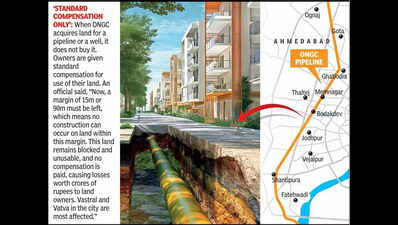Lifestyle
ONGC’s New Safety Margins Halt Development on 300 Hectares

A recent change in the margin requirements set by the Oil and Natural Gas Corporation (ONGC) has significantly disrupted development activities across more than 300 hectares in Ahmedabad. The oil and gas company has expanded its safety buffer zones for pipelines and wells, increasing the required distances from 12 meters to between 15 and 90 meters. This shift affects development plans in various areas, particularly in eastern regions such as Vatva, Vastral, and Nikol, where numerous ONGC pipelines traverse.
According to an official from the Ahmedabad Municipal Corporation (AMC), the new regulations mean that all construction plans on plots containing ONGC wells or pipelines must receive prior approval from the company. “ONGC’s oil pipelines pass through several key areas in Ahmedabad, including Motera, Thaltej, Bodakdev, Ghatlodia, Vastral, Nikol, and Vatva, with wells located in Sola, Ognaj, and Vastral,” the official stated, requesting anonymity. The stricter buffer zones have effectively halted many landowners from submitting development plans for their properties.
The AMC official noted that four town planning schemes covering 300 hectares in areas like Vastral and Nikol have been adversely impacted. “An ONGC well can influence five to ten surrounding plots, necessitating a larger margin of undeveloped land,” he explained. For instance, a line that runs from Ghatlodia’s Sattadhar Crossroads to SG Road in Ahmedabad previously allowed for a 12-meter margin, but redevelopment now requires a 15-meter clearance.
The implications extend beyond the city limits. Villages adjacent to Ahmedabad, such as Lilapur, are also affected by these new regulations. An official from the Ahmedabad Urban Development Authority (AUDA) clarified that pipelines are categorized as either ‘in use’ or ‘not in use’. Under the new mandate, a 15-meter buffer must be maintained even around non-operational pipelines. This change threatens to leave valuable land undeveloped, with the AUDA official stating, “The changes in ONGC regulations will impact not only urban areas but also villages like Lilapur, Jaspur, Borisana, Bareja, Kalol, and Sanand, where oil pipelines are present.”
The financial repercussions could be significant, as landowners and developers express concerns that the new rules will curtail potential development across numerous plots. With the cost of land in these areas often reaching into the millions of rupees, the restrictions imposed by ONGC could hinder urban and rural development alike.
As ONGC continues to enforce these new safety margins, property owners face an uncertain future regarding their development projects. The situation highlights the delicate balance between safety regulations and urban growth, raising questions about how such policies will shape the landscape of Ahmedabad in the years to come.
-

 World5 months ago
World5 months agoSBI Announces QIP Floor Price at ₹811.05 Per Share
-

 Lifestyle5 months ago
Lifestyle5 months agoCept Unveils ₹3.1 Crore Urban Mobility Plan for Sustainable Growth
-

 Science4 months ago
Science4 months agoNew Blood Group Discovered in South Indian Woman at Rotary Centre
-

 World5 months ago
World5 months agoTorrential Rains Cause Flash Flooding in New York and New Jersey
-

 Top Stories5 months ago
Top Stories5 months agoKonkani Cultural Organisation to Host Pearl Jubilee in Abu Dhabi
-

 Sports4 months ago
Sports4 months agoBroad Advocates for Bowling Change Ahead of Final Test Against India
-

 Science5 months ago
Science5 months agoNothing Headphone 1 Review: A Bold Contender in Audio Design
-

 Top Stories5 months ago
Top Stories5 months agoAir India Crash Investigation Highlights Boeing Fuel Switch Concerns
-

 Business5 months ago
Business5 months agoIndian Stock Market Rebounds: Sensex and Nifty Rise After Four-Day Decline
-

 Sports4 months ago
Sports4 months agoCristian Totti Retires at 19: Pressure of Fame Takes Toll
-

 Politics5 months ago
Politics5 months agoAbandoned Doberman Finds New Home After Journey to Prague
-

 Top Stories5 months ago
Top Stories5 months agoPatna Bank Manager Abhishek Varun Found Dead in Well









